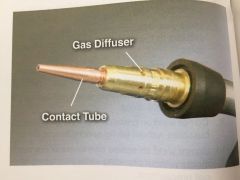![]()
![]()
![]()
Use LEFT and RIGHT arrow keys to navigate between flashcards;
Use UP and DOWN arrow keys to flip the card;
H to show hint;
A reads text to speech;
23 Cards in this Set
- Front
- Back
|
Explain the gas metal arc welding process (3 steps) |
1. the intense heat of the electric arc melts a continuous electrode wire and base metal 2. molten filler metal transfers across the arv to the work where it fuses with the base metal 3. shielding gas protects the molten weld puddle |
|
|
The power source supplies... |
welding amperage and voltage for the welding arc |
|
|
Most GMAW power sources are DC/VC, what does this stand for? |
direct current, constant voltage |
|
|
What controls arc length? |
Constant voltage |
|
|
What are the most commenly used shielding gases for GMAW on carbon steel? |
1. carbon dioxide (CO2) 2. a mixture of argon (Ar) and carbon dioxide 3. a mixture of argon and oxygen |
|
|
What kind of shielding gas do we use in the shop? |
A mixture of argon and carbon dioxide |
|
|
What is stick out? |
The length of unmelted electrode extending beyond the nozzle |
|
|
Why is maintaining proper stick out critical? |
Stick out affects amperage lengthen = decrease amp shorten = increase amp |
|
|
Explain short circuit transfer (5) |
1. molten filler droplet forms at tip of electrode, contacts the puddle and momentarily extinguishes the arc 2. this happens several hundred times per second 3. lower amperage and voltage 4. thinner diameter wire 5. able to weld in all positions |
|
|
Explain spray transfer (4) |
1. pinch force reaches the molten droplet and pinches it off, droplet transfers across the arc to the puddle 2. this happens several hundred times per second 3. higher amperage and voltage, in the presence of argon-rich shielding gas 4. spray transfer on ferrous metals is confined to flat and horizontal welds |
|
|
What happens when you press the trigger on the welding gun? |
1. Starts the flowof shielding gas 2. Starts the flow of the electrode wire 3. Closes the circuit that energizes the electrode |
|
|
What do the letters and numbers mean in electrode classification? (5) |
E = electrode R = filler metal rod # = minimum tensile strength S or C = solid or composite # or letter = chemical composition of the wire ex. "ER70S-6" |
|
|
What are the main parts of the welding gun? |

1. gas defuser 2. contact tube |
|
|
When does a drag angle exist? |
When the electrode points away away from the direction of travel. Increases penetration and produces a narrower, more convex weld bead. Used for welding 3/16 and thinner steel |
|
|
When does a push angle exist? |
When the electrode points in the direction of travel. It decreases penetration and the weld becomes wider and fatter. |
|
|
What are the two categories of shielding gasses? |
1. Reactive gas - interacts with the base metal and filler metal at high temperatures. Ex. CO2 and oxygen 2. Inert gas - does not interact with the filler metal and base metal therefore has no effect on the chemical characteristic of the weld. Ex. Argon and helium |
|
|
Describe that shielding gas! Carbon dioxide |
- reactive gas - interacts with base and filler metal at high temperatures - deeper penetration and high electrode burn-off rates - more likely to use CO2/argon for short circuit |
|
|
Describe that shielding gas! Argon |
- inert gas - doesn't react with filler or base metal - much lower heat input than CO2 |
|
|
Describe that shielding gas! Argon/CO2 |
- 75% argon, 25% CO2 - exhibits less spatter and better arc stability than CO2 alone |
|
|
Describe that shielding gas! Helium |
- inert gas - silimar to CO2 in its ability to generate heat input - tri-mix of 90% helium 7.5% argon, and 2.5% CO2 promots short circuit transfer on stainless steel |
|
|
Describe that shielding gas! Oxygen |
- small amounts are added to argon to stabalize arc and minimize spatter - reactive gas -provides heat input that makes the puddle more fluid - limited to 5% because higher levels create porosity problems |
|
|
Describe that shielding gas! Argon/helium |
- used on aluminum or aluminum alloys |
|
|
What are the safety procedures when storying, using, or moving compressed gas cylinders? (4) |
1. Handle with extreme care 2. Keep caps on when not in use 3. Ensure they are secured to the wall or other structural supports 4. If empty, close valve and mark EMPTY |

